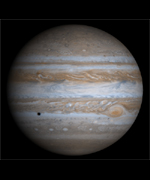
Image credit: NASA/JPL
In a study published in Geophysical Research Letters (Vol. 31, No.13), University of South Florida College of Marine Science professor Boris Galperin explained a link between the movement and appearance of ocean currents on Earth and the bands that characterize the surface of Jupiter and some other giant planets.
“The banded structure of Jupiter has long been a subject of fascination and intensive research,”said Galperin, a physical oceanographer who analyzes turbulence theory and applies theory and numerical modeling to analyze planetary processes. “The visible bands on Jupiter are formed by clouds moving along a stable set of alternating flows.”
Galperin and colleagues have discovered that the oceans on Earth also harbor stable alternating bands of current that, when modeled, reveal a striking similarity to the bands on Jupiter due to the same kinds of “jets.”
“We think this resemblance is more than just visual,” he said. “The energy spectrum of the oceanic jets obeys a power law that fits the spectra of zonal flows on the outer planets.”
The observation begs the question of whether the similar phenomena are rooted in similar physical forces.
“To answer this question,” said Galperin, “one needs to determine what physical processes govern the large-scale dynamics in both systems.”
According to Galperin, there is a similarity in the forcing agents for planetary and oceanic circulations. The study maintains that both sets of zonal jets – the ocean’s bands of currents and the bands of Jupiter’s clouds – are the result of an underlying turbulent flow regime common in nature.
Comparing the energy spectra on giant planets and in the Earth’s oceans can yield valuable information about the transport properties of the oceans, said Galperin, especially about the strongest currents in the mid-depth ocean.
“The implications of these findings for climate research on Earth and the designs of future outer space observational studies are important,” he explained.
Galperin (http://www.marine.usf.edu/phy/galperin.html) and colleagues Hideyuki Nakano, Meteorological Research Institute, Ibaraki, Japan; Huei-Ping Huang, Lamont-Dougherty Earth Observatory of Columbia University, Palisades, New York; and Semion Sukoriansky, Center for Aeronautical Engineering Studies, Ben Gurion University of the Negev, Beer-Sheva, Israel, reported their research at the 25th Conference of the International Union of Geodesy and Geophysics’s Committee on Mathematical Geophysics, held June 16-18 at Columbia University.
Funding for the study came from the Army Research Office and the Israel Science Foundation.
Original Source: USF News Release
